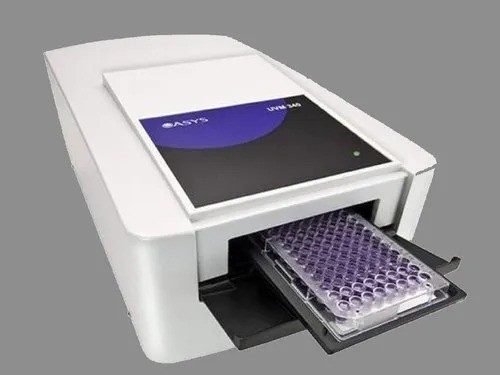Elisa Readers or Enzyme-Linked Immunosorbent Assay Readers is a specialized instrument designed to detect and measure the optical signals produced during an ELISA assay. This equipment is crucial for evaluating the results of assays performed on 96-well plates, which are the most commonly used format in ELISA experiments.
The plate reader can function both as a fluorimeter and a spectrophotometer, allowing it to measure fluorescence, chemiluminescence, and absorbance signals. By providing quantitative data on the signal intensity in each well, the ELISA plate reader enables the simultaneous analysis of multiple samples under various conditions.
These devices are crucial in diagnosing diseases, monitoring treatment, and conducting research. Despite their benefits, a Berthold Elisa analyzer can be costly and demand skilled personnel for operation. Understanding their advantages and limitations helps in making informed decisions regarding their use in laboratory settings.
Advantages and Disadvantages of ELISA
Here, we’ll explore the advantages and disadvantages of ELISA.
Accuracy And Precision
The Elisa Reader is known for its high sensitivity. It can detect very low levels of substances. This makes it very useful in medical tests. Doctors use it to find diseases early. This early detection can save lives. The machine is also very precise. It gives the same result each time. This makes it reliable for repeated tests.
Errors can happen with the Elisa Reader. Small mistakes in handling can cause big problems. Contaminated samples can give false results. This can lead to wrong diagnoses. Proper training is required to use the machine well. Even then, mistakes can still occur. Regular maintenance of the machine is also needed. Without it, accuracy can drop.
Speed And Efficiency
Elisa readers deliver rapid results. They process samples quickly. This speed helps in urgent tests. Doctors can make decisions faster. Patients get their results sooner. Laboratories can handle more tests daily. This efficiency boosts productivity.
Elisa readers support batch processing. Multiple samples are tested at once. This saves time and resources. Large-scale studies become manageable. Results are consistent and reliable. Automation reduces human errors. Labs achieve higher throughput.
Cost Considerations
Elisa readers offer precise and automated results, improving efficiency in laboratories. Despite their benefits, the high initial cost can be a drawback for smaller labs.
Buying an Elisa Reader can be expensive. It requires a significant initial investment. This is because the technology is advanced. Labs need to budget carefully. The cost might be a barrier for some. Smaller labs might struggle more with this expense. But the device is valuable for many tests.
Keeping an Elisa Reader in good shape costs money. Regular maintenance is important. Parts might wear out over time. Replacing these parts can be costly. Some labs need to hire experts for this. Regular checks ensure accurate results. Proper care extends the device’s life.
User-friendly Interface
Elisa readers have a very simple design. Even beginners can use them easily. The buttons are clear and easy to understand. Many users appreciate the clear display screen. This helps in reading results quickly.
No special skills are needed to operate it. Instructions are usually easy to follow. Elisa readers often come with user manuals. These manuals guide you step-by-step. Training time is usually short. Most people learn to use it in just one day.
Minimal training is needed for Elisa readers. Basic knowledge of lab work is enough. Online tutorials are available for extra help. Some companies offer free training sessions. These sessions are short and to the point.
Practice tests are often included. This helps users get comfortable quickly. Users can also find video guides online. These videos show each step clearly. With a little practice, anyone can master it.
Versatility
Elisa Readers are used in many fields. They help in medical diagnostics and food safety. Scientists use them for research. Elisa Readers test for many different substances. They can detect proteins, hormones, and antibodies. This makes them very useful.
Elisa Readers are not perfect. They can’t be used for all tests. Some tests need more advanced tools. False positives can occur sometimes. False negatives can happen too. These errors can affect results. Elisa Readers need proper calibration. Without it, the results may be wrong.
Automated Data Recording
Elisa readers help in automating data recording. This reduces human errors. The process becomes faster and more efficient. All data gets recorded accurately. This helps in reliable results. Automated systems save time and effort. Manual recording is no longer needed. This improves overall productivity.
Data Security Concerns
Using Elisa readers may pose data security risks. Sensitive data might be vulnerable to hacks. Unauthorized access can happen. Proper security measures are essential.
Regular updates help in protecting data. Data encryption can add a layer of security. Staff should be trained on data security practices. Security protocols need to be followed strictly.
Conclusion
Elisa Readers offer significant benefits like precise results and automation. However, they come with disadvantages such as high costs and maintenance needs. Understanding both sides helps make informed decisions.
Choose wisely based on your lab’s needs and budget. Investing in the right equipment enhances research efficiency and accuracy.

Comments are closed, but trackbacks and pingbacks are open.